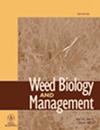增强杂草-作物竞争对耐除草剂和易受除草剂影响的一年生大豆生长和种子生产的影响
IF 1.5
4区 农林科学
Q3 AGRONOMY
引用次数: 6
摘要
加强作物竞争有助于管理澳洲种植系统的优势杂草——一年生蓟(Sonchus oleaceus L.)。通过盆栽试验,研究了小麦(Triticum aestivum L.)种植密度(0、82和164株/m)对一年生蓟抗草甘膦(GR)和敏感草甘膦(GS)生物型生长和种子产量的影响。在没有竞争的情况下,两种生物型产生的叶片数量和生物量相似,但GS生物型比GR生物型多产生80%的种子(每株46050颗)。在164株/m的竞争条件下,与无竞争处理相比,GR和GS生物型的叶片数量分别减少了62%和61%,杂草生物量分别减少了78%和77%。与无竞争处理相比,当小麦密度为82株/m时,GR和GS生物型的种子产量分别减少了33%和69%,但当小麦密度从82株/m增加到164株/m时,只有GS生物型的种子数量减少(81%)。在以164株/m的竞争条件下,两种生物型的单株种子产量均大于6000粒,这表明增加作物密度应与其他杂草管理策略相结合,以有效控制一年生蓟草。本文章由计算机程序翻译,如有差异,请以英文原文为准。
Enhanced weed‐crop competition effects on growth and seed production of herbicide‐resistant and herbicide‐susceptible annual sowthistle (
Sonchus oleraceus
)
Enhanced crop competition could aid in the management of annual sowthistle (Sonchus oleraceus L.), a dominant weed of Australian cropping systems. A two-year pot study was conducted to evaluate the effect of wheat (Triticum aestivum L.) planting densities (0, 82, and 164 wheat plants/m) on growth and seed production of glyphosate-resistant (GR) and glyphosate-susceptible (GS) biotypes of annual sowthistle. Without competition, both biotypes produced a similar number of leaves and biomass, but the GS biotype produced 80% more seeds (46,050 per plant) than the GR biotype. In competition with 164 wheat plants/m, the number of leaves in the GR and GS biotypes was reduced by 62 and 61%, respectively, in comparison with the no-competition treatment, and similarly, weed biomass was reduced by 78 and 77%, respectively. Compared to no-competition treatment, the seed production of GR and GS biotypes was reduced by 33 and 69%, respectively, when grown with 82 wheat plants/m, but increasing wheat density from 82 to 164 plants/m reduced the number of seeds only in the GS biotype (81%). Both biotypes produced greater than 6,000 seeds per plant when grown in competition with 164 plants/m, suggesting that increased crop density should be integrated with other weed management strategies for efficient control of annual sowthistle.
求助全文
通过发布文献求助,成功后即可免费获取论文全文。
去求助
来源期刊

Weed Biology and Management
农林科学-农艺学
CiteScore
2.70
自引率
0.00%
发文量
13
审稿时长
>36 weeks
期刊介绍:
Weed Biology and Management is an international journal, published four times per year. The journal accepts contributions in the form of original research and review articles in all aspects of weed science. Contributions from weed scientists in the Asia–Pacific region are particularly welcomed.
The content of the contributions may relate to weed taxonomy, ecology and physiology, weed management and control methodologies, herbicide behaviors in plants, soils and environment, utilization of weeds and other aspects of weed science. All contributions must be of sufficient quality to extend our knowledge in weed science.
 求助内容:
求助内容: 应助结果提醒方式:
应助结果提醒方式:


